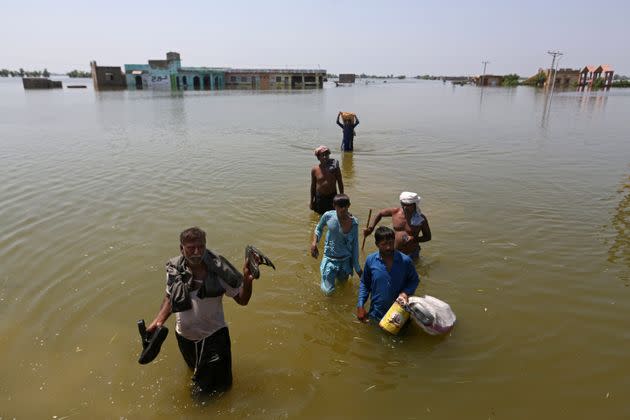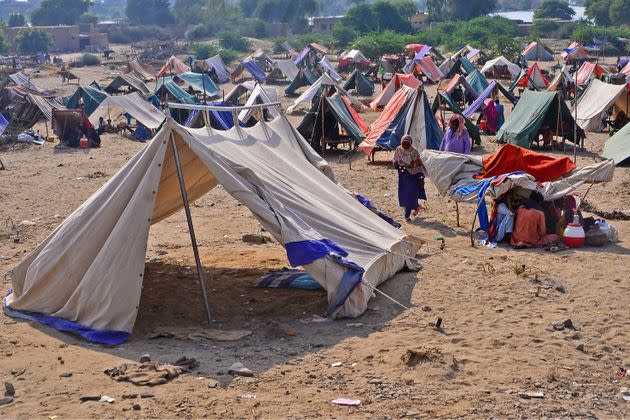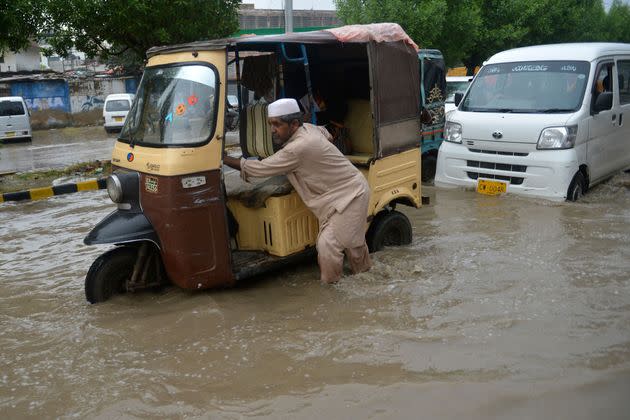Pakistan's Devastating Floodwaters Could Take 6 Months To Recede
Catastrophic floods in Pakistan have submerged large swaths of farmland, swallowed whole villages and turned some communities into islands ― and the water likely won’t be gone anytime soon.
Floodwaters will take an estimated three to six months to fully recede, Sindh province’s chief minister Syed Murad Ali Shah said in a statement, according to CNN. As of late August, the southern province had already gotten almost six times as much rainfall as its 30-year annual average.
Those rains combined with glacial melt have caused the flooding that has devastated the country.
“We are living on an island now,” cotton farmer Muhammad Jaffar told The New York Times in a story published this week. Filthy water had completely drowned his fields, along with the well he used for drinking water.

Victims of flooding from monsoon rains carry belongings salvaged from their flooded home in the Dadu district of Sindh Province, of Pakistan, Sept. 9, 2022. (Photo: AP Photo/Fareed Khan)
Pakistan’s National Disaster Management Authority said the floods have killed at least 1,314 people, including 458 children, according to The Guardian. Around 33 million others have been affected by the flooding. Many have had to flee their waterlogged homes to stay in shelters or tent encampments.

Internally displaced flood-affected people take refuge at a makeshift camp in Dadu district of Sindh province on Wednesday. (Photo: AFP via Getty Images))
And those who have been able to stay in their homes contend with lack of access to food, clean water and medicine. One woman told the Times that her teenage cousin has to swim 20 minutes through snake-filled floodwaters to get to a village and buy food for his family.
Disease-carrying mosquitoes also thrive in stagnant floodwaters. Sindh’s capital, Karachi, is facing an outbreak of the mosquito-borne virus dengue, with hundreds of thousands of cases, Pakistan’s climate minister Sherry Rehman said.

A man pushes his auto-rickshaw through a flooded street after heavy rains in Karachi on Tuesday. (Photo: RIZWAN TABASSUM/AFP via Getty Images)
Earlier this month, Pakistan’s foreign minister Bhutto Zardari called the flooding “a climate disaster of biblical proportions” in an interview with CNBC.
Climate change fueled the floods in multiple ways. Intense heat waves earlier in the year caused the air to hold more moisture, and meteorologists at the time said that would lead to “above normal” rain in the monsoon season, Islamabad water-resources engineer Zia Hashmi told the journal Nature. That same heat melted glaciers in the north of the country, swelling the rivers that lead to the south.
“Pakistan at this point in time, are paying in their lives and in their livelihoods for a climate disaster that is not of their making,” Zardari told CNBC. The network noted that while Pakistan contributes to less than 1% of the world’s carbon emissions, it’s one of the top 10 countries hit hardest by rising temperatures.
This article originally appeared on HuffPost and has been updated.

